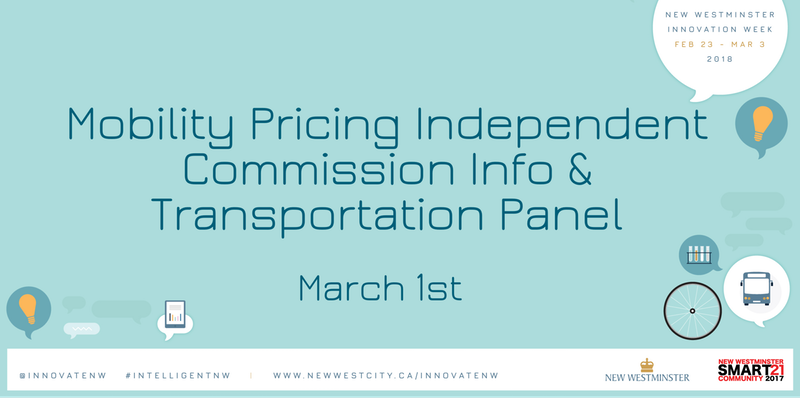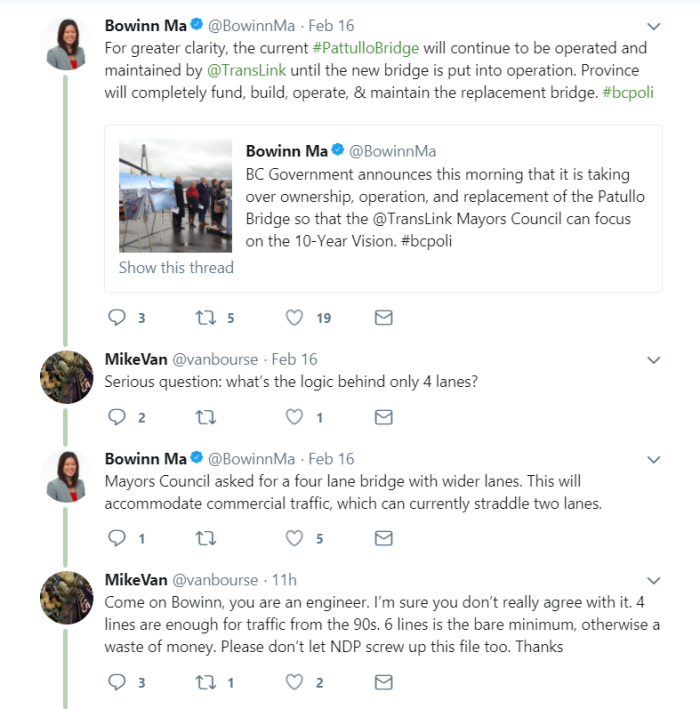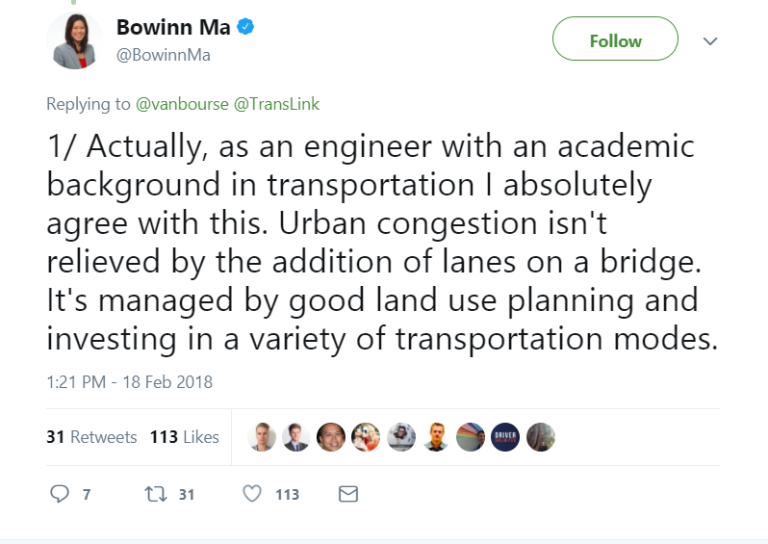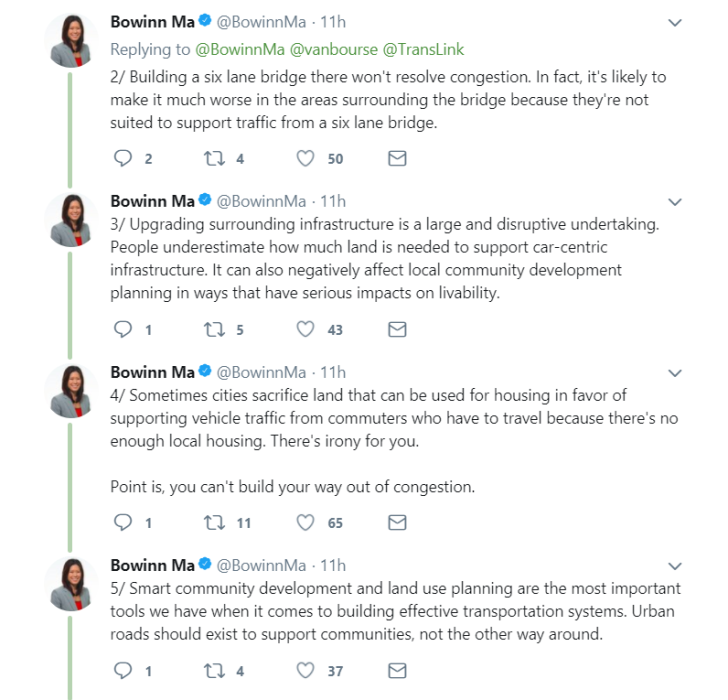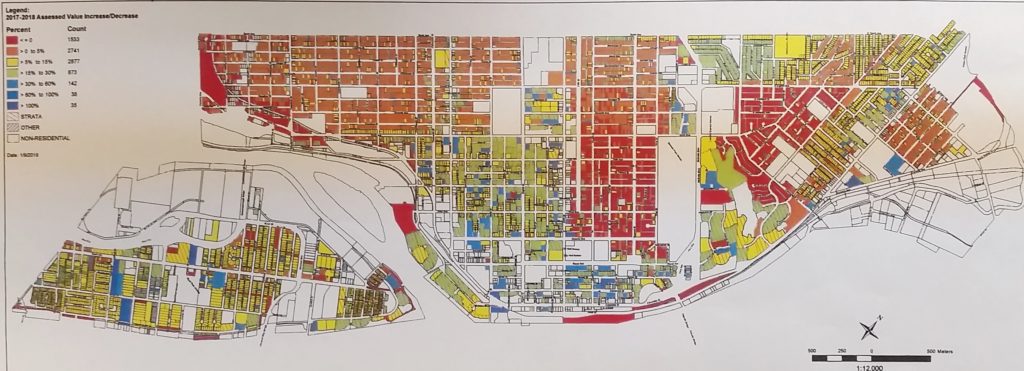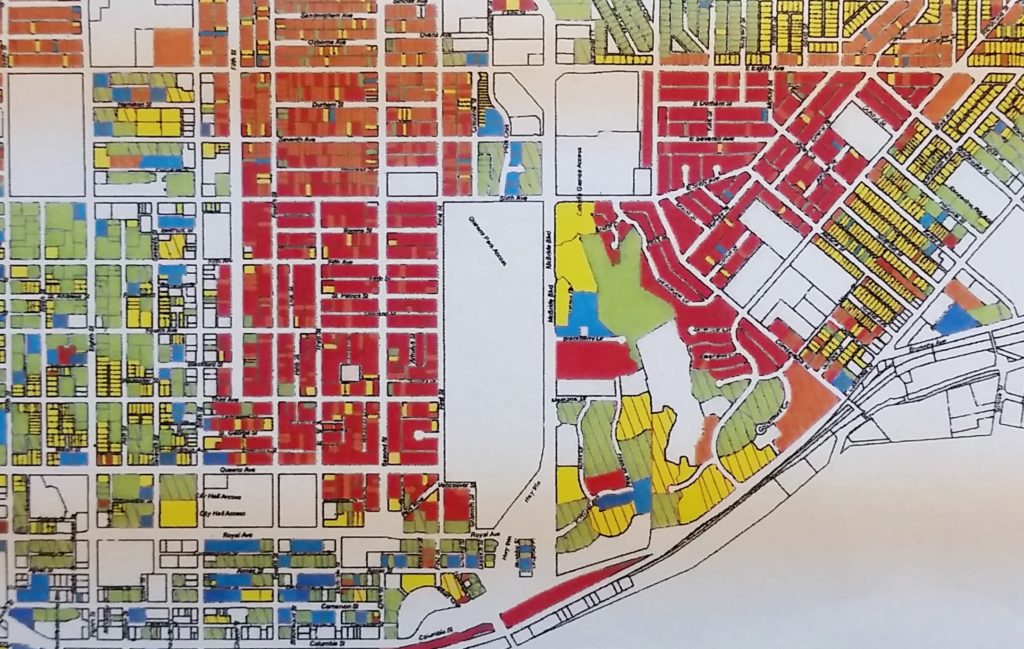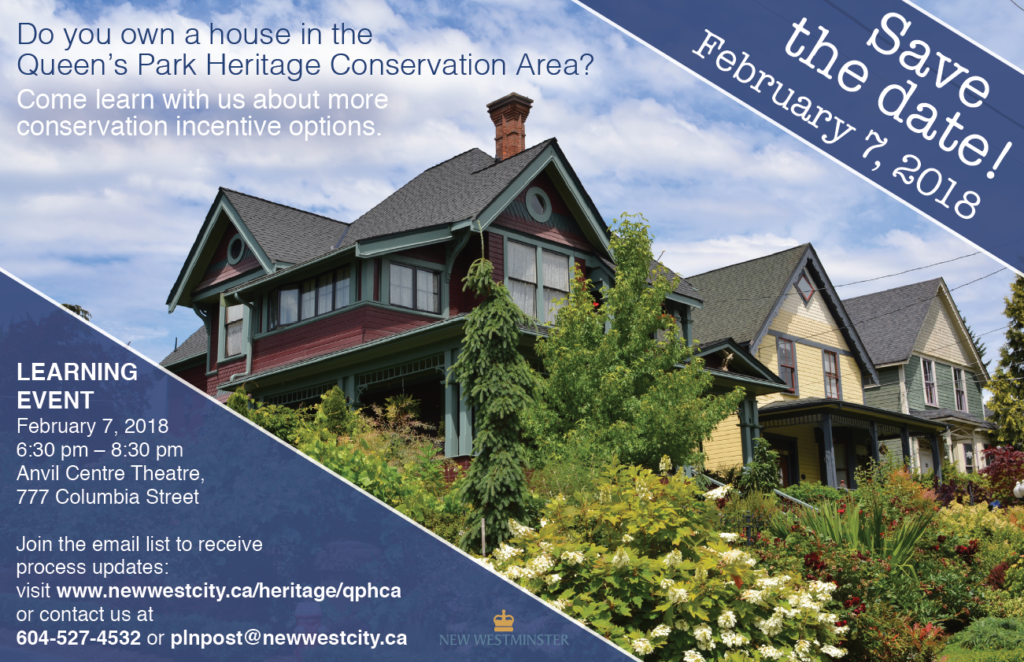I covered the January 29th Public Hearing in this earlier post. Our regular meeting began with Opportunities to be Heard on several development variance permits:
Commercial Vehicle Amendment Bylaw No. 7976, 2018
Queen City Taxi is applying yet again, through the long and complicated process, to get more taxi licenses in order to provide better service in New Westminster. The amendment of our local Bylaw is part of the process. They wish to expand service by three regular cabs and an accessible cab. I’ve ranted about this before.
We have one presentation from a resident who was concerned about lack of accessible cabs, and Council referred her concerns to the Access Ability Advisory Committee.
With no other presentations, Council moved to adopt the Bylaw Amendment.
Development Variance Permit DVP00637 for 430 Boyd Street, 350 and 354 Stanley Street and an unaddressed parcel
There are a couple of variances needed to make this 80-unit townhouse project in Queensborough fit better on the site. Tandem parking spaces allow more flexible layouts and some separation between buildings is slightly smaller than required by the zoning bylaw (on the order of a few feet at most) . We had no-one come to speak to the variances, and received no correspondence. The project was supported by the Residents’ Association and the Design Panel, and fits with the Queensborough Community Plan.
Council moved to approve the Variance and the subsequent Development Permit.
Development Variance Permit DVP00638 for 728 and 734 Ewen Avenue
Similar to the above project, there are a couple of variances needed to make this 37-unit townhouse project in Queensborough work, and again Tandem parking is the big one. We had no written submissions, but had the proponent present in favour. Again, this project is supported by the Residents’ Association, the Advisory Planning Commission, and the Design Panel. It fits the Community Plan and had a public hearing in 2014(!).
Council moved to approve the Variance and the subsequent Development Permit.
Development Variance Permit DVP00639 for 746 Ewen Avenue
This project is directly related to the neighbouring one above, and brings another 30 townhouse units to Queensborough, and had similar approvals from the community and committees. Council moved to approve the Variance and the subsequent Development Permit.
All told, that’s 149 relatively affordable family-friendly homes approved for Queensborough.
Following those Opportunities, we moved onto our regular agenda, starting with the following items Moved on Consent:
2018 New West Grand Prix
The 2017 was by so many measures a success, and we are getting ready to organize year two.
Last year we had few spills, but many thrills. As a cycling fan, the women’s race was particularly exciting, even as the eventual winner absolutely dominated. Kirstie Lay went on a suicide solo break that lasted for way too many laps. Each lap we thought she was surely going to get reeled in, but she kept the gap up in a Merckxian display of strength and determination. It was pretty cool.
Unlike Kirstie, we started a little late last year, and had a few organizational hiccups. They were small, and not really noticed by the fans or the racers, and we have learned a lot about how an event like this fits in New West. We have a head start this year, and things are already lining up. Volunteers and sponsors really made this a success. It was a fun event for the volunteers, many of them had no idea what a professional bicycle race looked like, and were amazed by the speed and the force with which this mass of athletes blasts past (they move a lot of air!). If you want a t-shirt, we always could use more volunteers!
Recruitment 2018: Recommended Appointments to Committees
This City relies on volunteers. They provide time and energy to get so many things done in the City, but they also give City Staff and Council guidance based on their subject matter expertise. Every year we have to sift through a large pile of applicants for Committee appointments. Here are the 179 appointees to 25 committees, commissions, or boards. Thank you all, and to the many others who applied but didn’t get picked – please apply again next year!
We have yet to adopt measures to assure diversity and representation on these committees – that is a work in progress and we will hopefully have an updated process for these appointments next year. I think we have a pretty good gender balance on these committees, 86 (48%) male, 93 (52%) female, but our process does not allow us to screen based on other demographics such as ethnicity or socio economic status. More to come…
Zoning Amendment (Housekeeping) Bylaw No. 7924, 2018: for Minor Updates/Corrections to Zoning Bylaw No. 6680, 2001 – Bylaw for First and Second Readings
There are several “housekeeping” changes required to one of our older but still valid Zoning Bylaws. They range from correcting spelling to updating definitions and fixing now-broken references to changed provincial regulations. These changes do, nonetheless, require a public hearing, so c’mon out on February 19 and let us know what you think.
232 Eleventh Street: Development Variance Permit DVP00640 for Height, Retaining Wall and Front Yard Parking – Notice of Opportunity to be Heard
A landowner want to build a single family house on a small, steeply sloped lot in the Brow Neighboruhood, and has a few challenges involving the roof height and accommodating off-street parking. This will go to an Opportunity to be Heard after reviewing with neighbours. I’ll hold my comments until after that process.
Temporary Use Permit for Amusement Arcade, 457 East Columbia Street
It looks like the arcade is back. Again, I am not sure what the concern is that led to the City restricting them back in 1990, but that was 28 years ago when I spent a little too much time playing Cabal up at Lester’s Arcade in Burnaby…
There will be an Opportunity to be Heard on the required Temporary Use Permit on February 19. C’mon out and let us know what you think!
Investment Report to December 31, 2017
The City has about $159 Million in the bank, mostly in group funds with the Municipal Finance Authority (see rant below). This annual report on our investments isn’t terrible news, but we are slightly behind where we want to be on returns on our investments.
Major Purchases September 1st to December 31st, 2017
This is our ternary report on major purchases. Mostly, this serves as the final step in our transparent procurement process. Bids are open, and the winning bid is reported out to assure that we are justifying purchase decisions.
810 Agnes Street – Rezoning and Special Development Permit for 29 Story Residential High Rise – Preliminary Report
This is a preliminary report on a large proposed residential development in the Downtown “Tower District”. There is a lot of work to do yet on this project, and there will be a public engagement process involving a Public Hearing, so I’ll hold my comments
Proposal to Amend the Terms of Reference of the ACTBiPed Committee
The Advisory Committee for Transit, Bikes, and Pedestrians has always had strong representation from local pedestrian advocates, but there has never been a formal Organizational representation like we have for cyclists (HUB has provided a representative for several years). The Committee wanted to create an opportunity for a pedestrian advocacy organization on the committee.
The following items were Removed from Consent for discussion:
Capture Photography Festival Public Art Project
You may recognize the large photographic pieces attached to a couple of brick walls in the City last year as part of this program. Our Public Art Advisory Committee is recommending taking part again in 2018, and have identified a priority location for an installation: The ugly fence along East Columbia at Sapperton Park.
In this report, the PAAC has recommended an artist to create the public art piece, which will be funded from our Public Art Reserve Fund. It is a great example of how Public Art doesn’t have to be a stand-alone piece in a square somewhere, but can be adding expression and aesthetic value to boring or dull infrastructure to make our communities nicer places to spend time.
Fire Escape Stairs at 642 Columbia Street Design and Public Art Integration
Speaking of boring or dull infrastructure, the fire escape built on Front Street is not the most elegant structure ever built. Once the rest of Front Street was improved, many noted it is incongruous to the new setting. An engineering marvel built to meet the newest fire escape standards, but ugly.
Luckily, the City has a Public Art Advisory Committee made up of City staff, arts professionals, and members of the public dedicated to bring aesthetics, expression, and creativity to our public spaces and advise us in how to integrate art and design into our community. When many of us see an ugly structure, they see a canvas waiting to be activated.
In this report, the PAAC is suggesting using some of the Public Art Reserve Fund to make this space work and look better. Council approved.
Corporate Record Management Bylaw 7987, 2018
This new proposed Bylaw will codify how the City manages its records. There is a bunch of regulation controlling how we, as a corporate entity, manage information. The Freedom of Information and Protection of Privacy Act balances the need to make information accessible while protecting privacy where needed. We have staff in City Hall whose job it is to manage these matters and assure all City operations comply with the law.
This Bylaw would formalize that the records management are the responsibility of the City Clerk, and would formalize the process through which old records are made digital and aging records are transferred to the City’s Archives for permanent storage or, if appropriate, destroyed.
1319 Third Avenue (Steel and Oak): Increase in Seating Capacity – Bylaw for First and Second Readings
Steel & Oak have a tasting room attached to their brewery in an industrial area in the Lower 12th area. They want to expand the seating capacity in their tasting room, but our Zoning Bylaw does not allow more than 30 people in an assembly space in our industrial areas. So they need a Zoning Amendment to allow the seat expansion. This will go to Public Hearing on February 19th, so I will hold my comments until then.
Queen’s Park Heritage Conservation Area: Summary of Community Consultation and Proposed Expansion of Incentives Work Plan
The Queens Park Heritage Conservation Area process is ongoing, as the City evaluates different types of incentives to encourage the preservation of heritage assets. The first round of community consultations around incentives discussed zoning-based incentives that may provide more building space entitlement (to build an extension to an existing house or a laneway/carriage house) or stratification of large homes. They were generally appreciated, but some people definitely wanted to see more, and we are giving staff the ability to explore a wider set of incentives and new rounds of public consultation. Here is a lot of good feedback from the neighbourhood and stakeholders here, and work to do!
Metro Vancouver’s Proposed Bylaw: Regional Wood Smoke Emission Regulation
Metro Vancouver is delegated the regulatory authority over Air Quality (smoke, emissions, dust, smells) by the Province, mostly because most of the causes of air quality problems are closely related to Municipal jurisdiction (zoning, business licensing), but the results of bad air quality crosses municipal boundaries. MV has the Bylaws and enforcement staff to manage this issue.
MV is bringing in regulations to reduce wood smoke pollution, and are phasing in these changes starting in 2020. They would ban using fireplaces in the summer (when the air quality impact is higher), and then would move towards requiring all fireplaces be registered and have a low-emission appliance. We had a great discussion with the Manager from Metro Vancouver during the meeting, which I think helped to clarify some of the questions around this proposed change. Metro is doing lots of public consultation on this (and no changes are planned until at least 2020), so let them know what you think!
2018 Spring Freshet and Snow Pack Level
Snow levels are not anomalous, and it is a la Nina season, so there is no increased or decreased risk of flood in the spring. Stay tuned!
Update to Investment Policy
I went on a bit of a rant here, as this is an issue we have talked about in the past, and despite some political will across the Province, we don’t seem to be able to make enough impact that the Provincial level.
We have discussed Divestment in the past, and have taken some action to UBCM and the Municipal Finance Authority, but we have never been successful at getting the MFA to provide ethical investment options to municipalities. Instead, the MFA tells us that divestment is a difficult problem that is really hard to solve. No news there.
When we invest in the oil industry we are investing in the value not of the oil in the ground, but of the value to be extracted when that oil is burned and the carbon released into the atmosphere. We are essentially betting that we can continue to put as much carbon into the atmosphere as we want, as long as it is profitable. We are betting against the continued stability of our climate, and against the same costs we are going to have to suffer as local governments as climate change worsens. I can’t support that.
So here we are, in New Westminster, fighting a bitumen pipeline on the Brunette River, yet our investments are supporting the other side of this fight. I believe it is our duty to divest, and I believe it is in our self-interest to divest.
Instead of supporting an update in our investment strategy that works against our own interest, we are going to take a better look at how we can make progress with the MFA, or what our other investing options are.
319 Ash Street: Development Variance Permit to Permit a Secondary Suite without a Parking Space – Consideration of Opportunity to be Heard
A homeowner in the Brow of the Hill wants to formalize a legal secondary suite, but lack of a back alley and trees up front make it hard to put in more parking, so they need a variance. This request will go to an Opportunity to be Heard on February 19, 2018; C’mon out and tell us what you think!
354 Johnston Street: Development Variance Permit for Minimum Frontage – Notice of Opportunity to be Heard; and
353 Johnston Street: Development Variance Permit for Minimum Frontage – Consideration of Opportunity to be Heard;
There was a bit of confusion about the wording of these two Variances on the agenda, but we got it clear. This is another case in Queensborough where very long lots are being subdivided to typical lot widths, but they run afoul of a requirement that lots can’t be more than 4x deep than they are long. This request will go to an Opportunity to be Heard on February 19, 2018; C’mon out and tell us what you think!
We then went through the Bylaw Readings:
Zoning Amendment (1319 Third Avenue) Bylaw No. 7981, 2018
As discussed above, Steel & Oak wants to expand seating capacity in their tasting room. Council gave this Bylaw amendment first and second reading. A Public Hearing will be held on February 19th, c’mon out and tell us what you think!
Zoning Amendment Bylaw No. 7924, 2018 (Housekeeping Bylaw): To Make Minor Updates/Corrections to Zoning Bylaw No. 6680, 2001
As discussed above, we need to make some minor changes to language of our zoning bylaws. Council gave these amendments first and second reading. A Public Hearing will be held on February 19th, c’mon out and tell us what you think!
Zoning Amendment Bylaw (Retail Sale of Cannabis) No. 7966, 2018
We had a long Workshop discussion in the afternoon about how to best approach the pending legalization of recreational cannabis sales. I will do another separate blog post on this topic (Part C!), but we agreed at that workshop to amend our Zoning Bylaw to formalize some of the language and our current approach as a temporary measure to prepare ourselves for July. This is more of a stopgap until July than anything else. It will go to Public Hearing on February 19th, C’mon out and tell us what you think.
Corporate Record Management Bylaw 7987, 2018
As discussed above, we are formalizing our Records Management in a Bylaw. Council Gave this Bylaw three readings.
Heritage Properties Maintenance Standards Bylaw No. 7971, 2018; and
Bylaw Notice Enforcement Housekeeping Amendment Bylaw No. 7973, 2018
These Bylaws in support of the goals of the Queens Park Heritage Conservation Area were given three readings last meeting, and are now Adopted. It’s now the Law of the Land. Adjust your building envelope maintenance schedule accordingly!
We had one late-addition item of New Business:
Restorative Justice for FCM
Councillor Puchmayr brought this item from the Restorative Justice Committee asking that Council support a resolution to FCM calling for the Federal Government to make Restorative Justice part of standard police training across the country. Council unanimously supported this motion.
Then we had a few Notices of Motion for future meetings, and called it a day. Stay tuned, as in the next few days I will write up Part C of this epic council report, talking about our Cannabis Regulation workshop.

